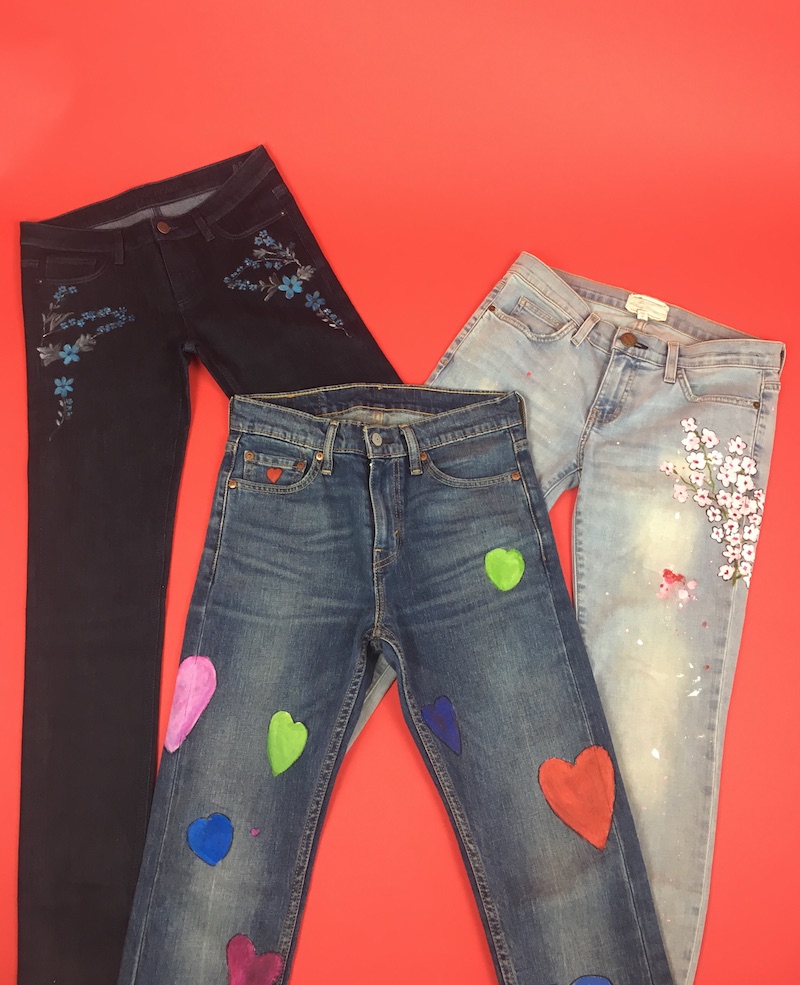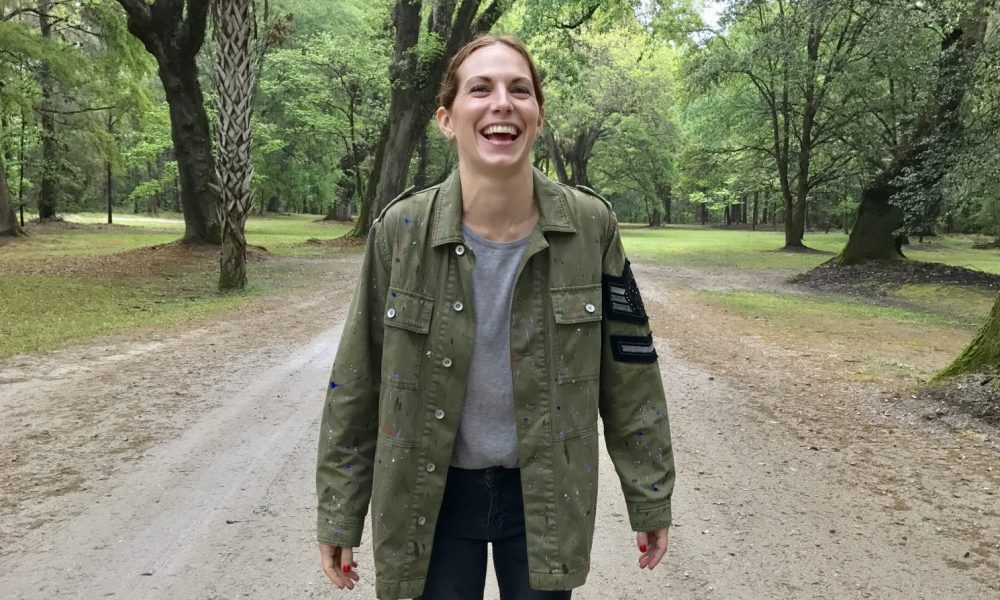By Andrea Karen Hammer
Caitlin Adler, a former pastry chef and bakery owner, launched the non-profit Project Ropa in 2015 to provide clothing, shoes and hygiene products to individuals experiencing homelessness in Los Angeles. People transitioning out of homelessness are also employed to upcycle and paint on vintage and designer women’s clothing, with the proceeds directly benefiting the non-profit. Here are some of her experiences while designing a business to help others.

Why did you decide to leave your work as a pastry chef and bakery owner? After working in the food industry for over a decade and eventually owning my own bakery, I got burned out and decided to step away from the kitchen. Initially, I thought I would one day return to baking, but it’s been more than 6 years now, and I still have no desire to go back into the kitchen.
What compelled you to start working on projects to help the homeless? I started Project Ropa because I saw a need. Before Project Ropa, the only way homeless people could get clothing was by going to a shelter or an organization. The problem with that was the restrictions that came along with that. It varies per organization, but some don’t allow animals inside, some are men only, some women only, the hours and days are limited. These restrictions along with quality and selection that is sub-par make getting clothing quite a difficult task. With Project Ropa, we bring the clothing to people experiencing homelessness, no restrictions.
When I moved to Los Angeles, I was immediately struck by the number of people living on the streets. I wanted to help the homeless and initially started going to Skid Row with a Meetup group to hand out clothing and food. Going to Skid Row and seeing the encampments and people in desperate need of basic necessities was an eye-opening experience that made me want to find a way to make a greater impact on the homeless community.
I had been thinking about the idea of creating a company that gave back to people experiencing homelessness. But it was more of a pipe dream that I never gave serious thought to. Then, I started volunteering at a local charity that assists people transitioning out of homelessness. They would provide their clients with job interview clothing but often had a shortage of larger sizes and a surplus of smaller sizes as well as everyday casual wear.
I asked other local organizations if they had a similar problem and discovered that they all had issues with inventory. But, none of the charities communicated with each other, and many gave the clothing items they couldn’t use to a third party that typically would sell the items and pocket the proceeds. They would do this primarily because it was convenient and they didn’t have storage space to keep the clothing donations they couldn’t use.
This was a big surprise to me. Initially, I started redistributing the unwanted clothing donations between a few local charities. Once a week, I would pick up the donations, spend a couple hours sorting and then redistribute them. I was doing freelance work at the time and had a flexible schedule, which allowed me to do this. I had read about an organization in San Francisco called Lava Mae that retrofitted a school bus into mobile showers for people experiencing homelessness. Inspired by them, I came up with the idea of creating a mobile pop-up “shop” that would take to the streets of Los Angeles to provide clothing, shoes and hygiene products using the leftover donations after I redistributed. Then, in 2016, Lava Mae expanded to Los Angeles and asked me to partner with them. I’ve been working with them ever since and have grown our network of organizations that we redistribute clothing donations to.
What would you say to those who carry some fear about interacting with the homeless? If you see someone experiencing homelessness, say hello and consider starting a conversation with them. Too often, people living on the streets are ignored and feel invisible. In my opinion, the greatest misconception is that people want to be homeless. While there are some who have mental health and/or addiction issues, a surprising number are actually employed but under-employed in low-paying jobs. They are intelligent, friendly and could have been your neighbor. Many have just had a catastrophe in their lives–losing a job, medical issue or rent increase that they couldn’t afford or overcome, and many women have been victims of domestic abuse. Once someone becomes homeless it is incredibly hard to get off the streets.
How and where does that process occur–workshops, teaching sessions or individual creations? I work one-on-one with the painter to come up with the design for each piece. All of the painting for our social enterprise is done in West Los Angeles.
How do you get and distribute the supplies for redesigning/painting clothes? All of the clothing we use to upcycle for our social enterprise is donated to us by individuals or organizations. Rather than selling them for a fraction of their retail value to a consignment or re-seller shop, I came up with the idea of hiring people transitioning out of homelessness to paint on the designer and vintage women’s clothing to create a one-of-a-kind wearable art pieces. All of the proceeds go directly back into the non-profit. We currently sell our upcycled clothing on our website at www.projectropa.org and at local markets.

How do you balance the creative/practical needs of this business, and what have you learned? Helping the homeless and being out on the streets is similar to working in the kitchen in many ways. You have to be able to quickly adapt and problem solve on the fly. I’ve always been a creative person, that’s part of what attracted me to baking and working in the kitchen. But, I’ve also always been interested in fashion and the creative design process. Prioritizing and delegating tasks I’ve learned is key to maintaining my sanity as well as the needs of the organization.
How has collaborating and partnering with other groups like Sew Swag made a difference? Through our partnerships with organizations such as Sew Swag, we are able to make sure that all of the clothing we receive is given to people in need including all stained, ripped and dated clothing, which is upcycled.
What do you need the most right now to advance your work during the next year? We need funding to continue doing our work and grow our organization. We want to expand our service days and locations to restore dignity and provide basic necessities to more people experiencing homelessness in Los Angeles. In order to do so, we need money to purchase and retrofit a delivery truck into a mobile clothing and hygiene service. Our goal is that ultimately our social enterprise will generate an income that will support our non-profit as well as employ people transitioning out of homelessness.
What are some of the greatest challenges and rewards that you’ve experienced? Well, there have been many victories, but a defining moment was when I had been running Project Ropa for about a year. I was in Venice at one of our weekly pop-ups when I saw a homeless man wearing an incredibly beautiful pair of hand-painted jeans. When I realized he had painted them himself, I had an “aha” moment, and the next day my mission became clear. From that moment, I knew there was a way to not only use the donations we had to provide clothing to people experiencing homelessness but to employ individuals transitioning out of homelessness and help the environment by creating a zero-waste fashion bran, which prioritizes used, up-cycled and recycled materials while minimizing waste in the production process.

By restoring dignity and rekindling optimism through employment, on-the-job training and life skills, we are ensuring that the homeless individuals employed by Project Ropa can break free and become self-sufficient, productive members of society. All of the proceeds from our social enterprise go directly back into the non-profit. The biggest challenge that Project Ropa has is access to capital. All of our operations are currently funded through donations and fundraising efforts. Last year, we received a small grant from The Pollination Project, which was incredibly helpful and appreciated. But, in general, we have found that getting funding from grants as a small non-profit is very difficult because there are so many rules and restrictions. That is one of the reasons why we came up with our social enterprise.

